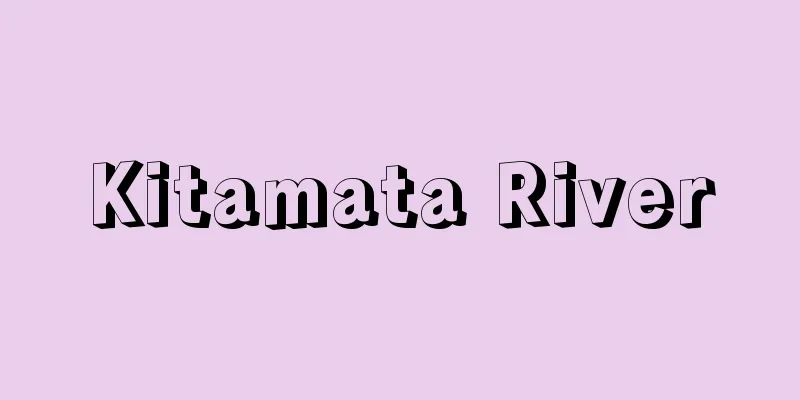Ainu language - Ainugo

|
Along with Japanese, it is a language that has been spoken in the Japanese archipelago since ancient times. It is the language unique to the Ainu people of Hokkaido. Until the end of World War II, it was also spoken in southern Karafuto (Sakhalin) and the so-called "Northern Territories". It was also spoken in the northern Tohoku region of Honshu until the Edo period, and in the northern Kuril Islands until the forced relocation by the Japanese government in 1884. Going back in time, it is known to have been distributed even more widely, and place names in Ainu remain from the southern tip of the Kamchatka Peninsula in the north to the southern Tohoku region in the south. Currently, there are only a few speakers in Hokkaido, and it is not used in daily life. However, in recent years, with the momentum for preserving and reviving Ainu culture growing, a language revival movement is continuing, and a small number of new speakers are being developed. [Tankiku Itsuji] characterTraditionally, it does not use characters, but since the Meiji period, it has sometimes been written using romaji, katakana, etc. When writing in katakana, a handakuten (half voiced mark) is sometimes used on the to to represent the romaji tu. [Tankiku Itsuji] dialectDespite its geographical spread, there are not as many dialect differences as there are in Japanese. It is broadly divided into the Hokkaido dialect, the Sakhalin dialect, and the Northern Kuril dialect. Of these, it is said that there are no longer any speakers of the Northern Kuril dialect. There is also a possibility that there used to be a unique dialect in the Tohoku region. Of these, the Hokkaido dialect has the largest number of speakers and is the one that has been most studied. [Tankiku Itsuji] phonemeIt has a relatively simple phonological system among the languages of northern Far East Asia. There are five vowels: a, e, i, o, u. The Hokkaido dialect has a pitch accent. The Sakhalin dialect distinguishes between long and short vowels. The consonants are p, t, k, c, s, r, m, n, w, y, h, ʔ. They are almost the same as Japanese, but there is no distinction between clear and voiced sounds. The syllable structure is also simple, but unlike Japanese, it has closed syllables ending with p, t, k, etc. [Tankiku Itsuji] grammarThe word order is SOV (subject-object-verb), and the word order of auxiliary verbs is similar to that of Japanese, but negators are placed before the verb. Unlike Japanese, there are no tenses (verbs do not distinguish between present and past tense). núman sirpirka "it was sunny yesterday" tanto sirpirka "it is sunny today". There is no distinction between adjectives and verbs. For example, poro can have two meanings, "big" or "become big", depending on the context. Verbs are always accompanied by personal suffixes. ku-sina "I tie up", eci-sina "you tie up", or "I tie up you". Some basic verbs have singular and plural conjugations. an "there is" oka "there is (plural things). Unlike Japanese, which basically only has suffixes, prefixes are well developed. sina "to tie up" ko-sina "to tie up" yay-ko-sina "to tie one's body to" Also, objects can be inserted between the suffix and the verb stem (object inclusion). kina ku-kar "I take grass" and ku-kina-kar "I take grass". As a result, the verbs become longer back and forth, and sometimes words become like sentences. si-e-apa-maka-yar "to open the door for myself" = "to have someone open the door for me." [Tankiku Itsuji] VocabularyAlthough there are not as many as Chinese characters in Japanese, there are old loanwords between neighboring languages. Ainu rakko → Japanese "otter". Japanese "tsuki" (cup) → Ainu túki. Nivkh tlangi → Ainu tunakay → Japanese "reindeer". There are also common words that are so old that it is difficult to tell whether they are loanwords or not, such as Japanese "kami" (god) and Ainu kamuy (god/nature). During the Edo period, the Matsumae clan's policies prevented the Ainu from learning Japanese, and from the Meiji period onwards, they forced the Ainu to use Japanese and oppressed the Ainu language. As it was a culture without written language, there was no increase in vocabulary through the translation of books. As a result, there is a lack of modern vocabulary. For example, not only are there words to express units such as hours, minutes, and seconds, but there are also cases where there are no words that perfectly express the concept of "time". However, there is an extremely rich vocabulary related to hunting, fishing, etc. Unique vocabulary is sometimes used in oral literature. It is a language with a high ability to coin words, and the entire picture of the vocabulary has not been grasped. [Tankiku Itsuji] Lineage and typologyThere are various theories, but the genealogical relationship is unclear. Typologically, it has both characteristics of so-called Altaic languages such as Turkish and Mongolian, with their developed suffixes, and characteristics of Old Asian languages such as Chukchi, with their developed prefixes and noun inclusion. [Tankiku Itsuji] Research HistoryThe oldest record of the Ainu language, excluding unclear ancient Japanese documents and personal names found in Chinese documents from the Yuan dynasty, is from the 17th century by Christian missionary Angelis. Around the same time, a Japanese Ezo interpreter compiled a vocabulary. After Japan's isolation ended in the 19th century, missionary Batchelor wrote grammatical descriptions and published a dictionary. In the 20th century, Kindaichi Kyosuke began serious research into the language, and Chiri Mashiho established the foundations for modern research. [Tankiku Itsuji] "The Collected Works of Mashiho Chiri, 6 volumes (1973, Heibonsha)" ▽ "The Complete Works of Kyosuke Kindaichi, Volumes 5-12" (1993, Sanseido) ▽ "The Ainu Language is Alive, by Pon Huci (1976, Shinsensha)" ▽ "Yukara is Revived, by Pon Huci (1978, Shinsensha)" ▽ "The Road to Ureshipamoshiri, by Pon Huci (1980, Shinsensha)" ▽ "Akoroitaku Ainu Language Text 1, edited by the Hokkaido Utari Association (1994, Cruise)" ▽ "Express Ainu Language, by Nakagawa Hiroshi and Nakamoto Mutsuko (1997, Hakusuisha)" ▽ "Illustrated Ainu Conversation Dictionary, by Chiri Mutsumi and Yokoyama Takao (1988, Kogyusha)" ▽ "Ainu Dialect Dictionary" edited by Hattori Shiro (1964, Iwanami Shoten)" ▽ "Ainu-English-Japanese Dictionary" 4th edition by J. Batcheler (1938, Iwanami Shoten)" ▽ "Classified Ainu Language Dictionary" by Chiri Mashiho (included in Chiri Mashiho Collected Works, Volumes I and II, 1975-1976, Heibonsha)" ▽ "Ainu Chitose Dialect Dictionary" by Nakagawa Yutaka (1995, Sofukan)" ▽ "Kayano Shigeru's Ainu Dictionary" (1996, Sanseido)" ▽ "Ainu Saru Dialect Dictionary" by Tamura Suzuko (1996, Sofukan) " ▽ "Karafuto Ainu Language" by Murasaki Kyoko (1976, Tosho Kankokai)" ▽ "Studies on Ainu Epic Poems, Myths and Sacred Traditions" by Kubodera Itsuhiko (1977, Iwanami Shoten)" ▽ "Ainu Myths Collection" by Chiri Yukie (1978, Iwanami Bunko)" ▽ "Ainu Folktales Collection" by Chiri Mashiho (1981, Iwanami Bunko)" ▽ "Ainu Language Audio Materials 1-11" edited by Tamura Suzuko (1984-, Waseda University Language Education Research Institute) ▽ "Kamuy Yukara and Folktales" by Kayano Shigeru (1988, Shogakukan)" ▽ "Ainu Language" by Tamura Suzuko (Encyclopedia of Linguistics, Vol. 1, World Languages (Part 1), 1988, Sanseido)" ▽ "Kamuy Yukara" edited by Katayama Ryuho (1995, Katayama Language and Culture Research Institute)" ▽ "Ueda Toshi's Uepekere" (1997, Ainu Museum) by Ueda Toshi ; "Kayano Shigeru's Collection of Ainu Mythology" 10 volumes (1998, Shogakukan) by Kayano Shigeru [References] | | [Supplementary information] |Source: Shogakukan Encyclopedia Nipponica About Encyclopedia Nipponica Information | Legend |
|
日本語とならび古来より日本列島で話される言語。北海道のアイヌ民族固有の言語。第二次世界大戦終結までは樺太(からふと)(サハリン)南部およびいわゆる「北方領土」でも話されていた。また本州東北地方北部では江戸時代まで、北千島列島では1884年の日本政府による強制移住まで話されていた。時代をさかのぼるとさらに広く分布していたことがわかっており、北はカムチャツカ半島南端から南は東北地方南部までアイヌ語による地名が残っている。現在は北海道に少数の話し手がいるだけで、日常生活では使用されていない。しかし近年アイヌ文化の保存・復興運動の機運が高まるなかで言語復興運動が続いており、わずかながら新たな話し手が育ちつつある。 [丹菊逸治] 文字伝統的には文字を用いないが、明治時代以降はローマ字、カタカナなどを用いて表記されることもある。カタカナ表記のさい、ローマ字表記のtuを表すのにトに半濁点を用いることがある。 [丹菊逸治] 方言地域的な広がりのわりには日本語ほどの方言差はない。北海道方言、樺太方言、北千島方言に大別される。そのうち北千島方言の話し手はすでに存在しないといわれている。なお、東北地方でも独自の方言があった可能性がある。これらのうち北海道方言がもっとも話者人口が大きく研究も進んでいる。 [丹菊逸治] 音韻極東アジア北方の諸言語のなかでは比較的簡単な音韻体系をもつ。母音はa,e,i,o,uの五つ。北海道方言は高低アクセントをもつ。樺太方言には長母音と短母音の区別がある。子音はp,t,k,c,s,r,m,n,w,y,h,ʔ。日本語とほぼ同じだが、清濁の区別はない。音節構造も単純だが、日本語と異なりp,t,kなどで終わる閉音節をもつ。 [丹菊逸治] 文法語順はSOV(主語・目的語・動詞)であり、助動詞などの語順も日本語と似ているが、否定詞は動詞に前置される。日本語と異なり時制をもたない(動詞に現在形・過去形の区別がない)。núman sirpirka「昨日は晴れていた」tanto sirpirka「今日は晴れている」。形容詞と動詞の区別がない。たとえばporoは文脈により「大きい」と「大きくなる」の二つの意味をもつ。動詞にはかならず人称接辞がつく。ku-sina「私が・~をしばる」eci-sina「あなたたちが・~をしばる」あるいは「私があなたたちを・しばる」など。基本的な動詞には単複の語形変化をもつものがある。an「ある」oka「(複数のものが)ある」。基本的に接尾辞しかもたない日本語と異なり、接頭辞が発達している。sina「~をしばる」ko-sina「~に・~をしばる」yay-ko-sina「自分の体を・~に・しばる」。また接辞と動詞語幹の間に目的語などが挟み込まれることがある(目的語包合)。kina ku-kar「草を 私は・取る」に対して、ku-kina-kar「私は・草・を取る」そのため動詞が前後に長くなり、まるで文章のような単語ができることもある。si-e-apa-maka-yar「自分・について・戸を・開ける・させる」=「人に戸を開けてもらう」。 [丹菊逸治] 語彙(ごい)日本語における漢語ほど多くはないが、隣接諸言語との間に古い借用語がみられる。アイヌ語rakko→日本語「ラッコ」。日本語「杯(つき)」→アイヌ語túki。ニヴフ語tlangi→アイヌ語tunakay→日本語「トナカイ」。また日本語の「神(かみ)」とアイヌ語のkamuy「神/自然」など借用語かどうか判別できないほど古い共通語彙もある。 江戸時代には松前藩の政策によりアイヌ民族の日本語習得が阻害され、明治時代以降は逆に日本語の強要とアイヌ語への圧迫が行われた。文字を使用しない文化であったため、書物の翻訳を通じた語彙の増加もなかった。そのため近代的な語彙が不足している。たとえば時・分・秒といった単位を表す言葉だけでなく、「時間/時刻」という概念を表すぴったりの語そのものがないというケースもある。しかし、狩猟・漁労などに関する語彙は非常に豊かである。口承文学においては独特の語彙が用いられることもある。元来、造語能力の高い言語であり、語彙の全体像はつかめていない。 [丹菊逸治] 系統と類型諸説あるが系統関係は不明である。類型論的には接尾辞の発達したトルコ語、モンゴル語などのいわゆるアルタイ諸語的な特徴と、接頭辞の発達、名詞包合などチュクチ語などの古アジア諸語的な特徴の両方をもつ。 [丹菊逸治] 研究史もっとも古いアイヌ語の記録は、不明確な日本古代の資料、元代の中国資料にみられる人名を除けば、17世紀のキリスト教宣教師アンジェリスによるものである。ほぼ同時期に日本の蝦夷通詞(えぞつうじ)による語彙集が成立している。日本の鎖国が終わり19世紀になると宣教師バチェラーによる文法記述が行われ、辞書が刊行されている。20世紀になると金田一京助が本格的な研究をはじめ、知里真志保(ちりましほ)に至って現代的な研究の基礎がつくられた。 [丹菊逸治] 『『知里真志保著作集』全6巻(1973・平凡社)』▽『『金田一京助全集 第5~12巻』(1993・三省堂)』▽『ポン・フチ著『アイヌ語は生きている』(1976・新泉社)』▽『ポン・フチ著『ユーカラは甦える』(1978・新泉社)』▽『ポン・フチ著『ウレシパモシリへの道』(1980・新泉社)』▽『北海道ウタリ協会編『アコロイタク アイヌ語テキスト1』(1994・クルーズ)』▽『中川裕・中本ムツ子著『エクスプレス アイヌ語』(1997・白水社)』▽『知里むつみ・横山孝雄著『アイヌ語会話イラスト辞典』(1988・窩牛社)』▽『服部四郎編『アイヌ語方言辞典』(1964・岩波書店)』▽『J・バチラー著『アイヌ・英・和辞典』第4版(1938・岩波書店)』▽『知里真志保著『分類アイヌ語辞典』(『知里真志保著作集』別巻Ⅰ・Ⅱ所収・1975~1976・平凡社)』▽『中川裕著『アイヌ語千歳方言辞典』(1995・草風館)』▽『萱野茂著『萱野茂のアイヌ語辞典』(1996・三省堂)』▽『田村すず子著『アイヌ語沙流方言辞典』(1996・草風館)』▽『村崎恭子著『カラフト・アイヌ語』(1976・図書刊行会)』▽『久保寺逸彦著『アイヌ叙事詩神謡・聖伝の研究』(1977・岩波書店)』▽『知里幸恵著『アイヌ神謡集』(1978・岩波文庫)』▽『知里真志保『アイヌ民譚集』(1981・岩波文庫)』▽『田村すず子編『アイヌ語音声資料1~11』(1984~ ・早稲田大学語学教育研究所)』▽『萱野茂著『カムイユカラと昔話』(1988・小学館)』▽『田村すず子著「アイヌ語」(『言語学大辞典 第1巻 世界言語篇(上)』1988・三省堂)』▽『片山龍峰編『カムイユカラ』(1995・片山言語文化研究所)』▽『上田トシ著『上田トシのウエペケレ』(1997・アイヌ民族博物館)』▽『萱野茂著『萱野茂のアイヌ神話集成』全10巻(1998・小学館)』 [参照項目] | | [補完資料] |出典 小学館 日本大百科全書(ニッポニカ)日本大百科全書(ニッポニカ)について 情報 | 凡例 |
<<: Ainesidēmos - Ainesidēmos (English spelling)
>>: Ainu - Ainu (English spelling)
Recommend
Atriplex
...an annual plant of the Chenopodiaceae family (...
Takahashi Finance
Takahashi Korekiyo served as finance minister in ...
Emmy von N.
One of the cases reported by S. Freud in Studies o...
Circumcision of Christ - Christ Circumcision Day
…In an attempt to eliminate pagan customs, Christ...
Arashi Tachibana Saburou - Arashi Tachibana Saburou
…In 1787 (Tenmei 7), he took the stage name of Ki...
Moses Montefiore
1784‐1885 A British Jewish businessman. He was rel...
Huaraz (English spelling)
Huarás. The capital of Ancash Province in central ...
Priest - Sojo
〘Noun〙① The highest rank of the priests. Also, the...
Tell Harmal
…The oldest known legal code written in Akkadian....
Ahbar - Ahbar
...They also do not accept any ijma (consensus) a...
Crabeater - Crabeater
...It is enjoyed as kabayaki, shirayaki, vinegare...
Revolutionary Syndicalist
…Unlike industrial unions, they were characterize...
Exogenous branching
…the apical meristem of a stem is derived from th...
Holotype
...This is called the type method, and is the pro...
Naoomi Tamura
1858-1934 A pastor from the Meiji period to the e...









